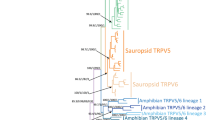Abstract
TRPML2, the polypeptide product of the gene Trpml2 (aka Mcoln2), is a member of the TRPML or mucolipin branch of the TRP super family of ion channels. Although no known agonists have been discovered, the wild type channel gives basal currents when heterologously expressed in Drosophila (S2) cells and is constitutively active in mammalian cells when bearing a cell degeneration-causing, proline to alanine substitution in the fifth trans-membrane domain. TRPML2 forms channels that are inwardly rectifying and permeable to Ca+2, Na+, and Fe+2. Localization studies indicate TRPML2 is present in lysosomes, late endosomes, recycling endosomes and, at a lower level, the plasma membrane. Tissue and organ distribution of TRPML2 is solely reported through RT-PCR and it is uncertain which cell types express this channel. However, various studies suggest that lymphoid cells express TRPML2. Although the function of TRPML2 is not known, distribution and channel properties suggest it could play roles in calcium release from endolysosomes, perhaps to mediate calcium-dependent events such as vesicle fusion, or to release calcium from intracellular acidic stores. However, TRPML2 may also function in the plasma membrane and its abundance in vesicles of the endocytic pathaway might occur because its presence in the cell surface is regulated by endocytosis and exocytosis. An evolutionary analysis of Trpml2 and its relatives reveals that vertebrate and invertebrate chordates have only one Trpml gene, that Trpml1 and Trpml2 are common to vertebrates, and that Trpml3 is only found in tetrapods. Ray-finned fishes contain another isoform, which we term Trpml4 or Mcoln4 (and its product TRPML4). Trpml2 is next to Trpml3 in all tetrapod genomes except that of the frog Xenopus tropicalis and of the domesticated pig, which seems to lack most of the Trpml3 gene. This close linkage across species implies that it is maintained by selective pressure and suggests that the regulation of both genes is interdependent.
Access this chapter
Tax calculation will be finalised at checkout
Purchases are for personal use only
Similar content being viewed by others
References
Di Palma F, Belyantseva IA, Kim HJ, Vogt TF, Kachar B, Noben-Trauth K (2002) Mutations in Mcoln3 associated with deafness and pigmentation defects in varitint-waddler (Va) mice. Proc Natl Acad Sci USA 99:14994–14999
Samie MA, Grimm C, Evans JA, Curcio-Morelli C, Heller S, Slaugenhaupt SA, Cuajungco MP (2009) The tissue-specific expression of TRPML2 (MCOLN-2) gene is influenced by the presence of TRPML1. Pflugers Arch 459:79–91
Grimm C, Jors S, Saldanha SA, Obukhov AG, Pan B, Oshima K, Cuajungco MP, Chase P, Hodder P, Heller S (2010) Small molecule activators of TRPML3. Chem Biol 17:135–148
Lindvall JM, Blomberg KE, Wennborg A, Smith CI (2005) Differential expression and molecular characterisation of Lmo7, Myo1e, Sash1, and Mcoln2 genes in Btk-defective B-cells. Cell Immunol 235:46–55
Grimm C, Cuajungco MP, van Aken AF, Schnee M, Jors S, Kros CJ, Ricci AJ, Heller S (2007) A helix-breaking mutation in TRPML3 leads to constitutive activity underlying deafness in the varitint-waddler mouse. Proc Natl Acad Sci USA 104:19583–19588
Nagata K, Zheng L, Madathany T, Castiglioni AJ, Bartles JR, Garcia-Anoveros J (2008) The varitint-waddler (Va) deafness mutation in TRPML3 generates constitutive, inward rectifying currents and causes cell degeneration. Proc Natl Acad Sci USA 105:353–358
Xu H, Delling M, Li L, Dong X, Clapham DE (2007) Activating mutation in a mucolipin transient receptor potential channel leads to melanocyte loss in varitint-waddler mice. Proc Natl Acad Sci USA 104:18321–18326
Lev S, Zeevi DA, Frumkin A, Offen-Glasner V, Bach G, Minke B (2010) Constitutive activity of the human TRPML2 channel induces cell degeneration. J Biol Chem 285:2771–2782
Dong XP, Cheng X, Mills E, Delling M, Wang F, Kurz T, Xu H (2008) The type IV mucolipidosis-associated protein TRPML1 is an endolysosomal iron release channel. Nature 455:992–996
Curcio-Morelli C, Zhang P, Venugopal B, Charles FA, Browning MF, Cantiello HF, Slaugenhaupt SA (2010) Functional multimerization of mucolipin channel proteins. J Cell Physiol 222:328–335
Karacsonyi C, Miguel AS, Puertollano R (2007) Mucolipin-2 localizes to the Arf6-associated pathway and regulates recycling of GPI-APs. Traffic 8:1404–1414
Song Y, Dayalu R, Matthews SA, Scharenberg AM (2006) TRPML cation channels regulate the specialized lysosomal compartment of vertebrate B-lymphocytes. Eur J Cell Biol 85:1253–1264
Venkatachalam K, Hofmann T, Montell C (2006) Lysosomal localization of TRPML3 depends on TRPML2 and the mucolipidosis-associated protein TRPML1. J Biol Chem 281:17517–17527
Zeevi DA, Frumkin A, Offen-Glasner V, Kogot-Levin A, Bach G (2009) A potentially dynamic lysosomal role for the endogenous TRPML proteins. J Pathol 219:153–162
Cheng X, Shen D, Samie M, Xu H (2010) Mucolipins: Intracellular TRPML1-3 channels. FEBS Lett 584:2013–2021
Dong XP, Shen D, et al. (2010) PI (3, 5) P2 Controls Membrane Traffic by Direct Activation of Mucolipin Ca Release Channels in the Endolysosome. Nat Commun 1(4):ii–38
Acknowledgments
Supported by grants from NIH-NINDS (R01 NS044363), NIH-NIAMS (P30 AR057216) and The Hugh Knowles Center for Clinical and Basic Science in Hearing and Its Disorders to JG-A.
Author information
Authors and Affiliations
Corresponding author
Editor information
Editors and Affiliations
Rights and permissions
Copyright information
© 2011 Springer Science+Business Media B.V.
About this chapter
Cite this chapter
Flores, E.N., García-Añoveros, J. (2011). TRPML2 and the Evolution of Mucolipins. In: Islam, M. (eds) Transient Receptor Potential Channels. Advances in Experimental Medicine and Biology, vol 704. Springer, Dordrecht. https://doi.org/10.1007/978-94-007-0265-3_12
Download citation
DOI: https://doi.org/10.1007/978-94-007-0265-3_12
Published:
Publisher Name: Springer, Dordrecht
Print ISBN: 978-94-007-0264-6
Online ISBN: 978-94-007-0265-3
eBook Packages: Biomedical and Life SciencesBiomedical and Life Sciences (R0)



